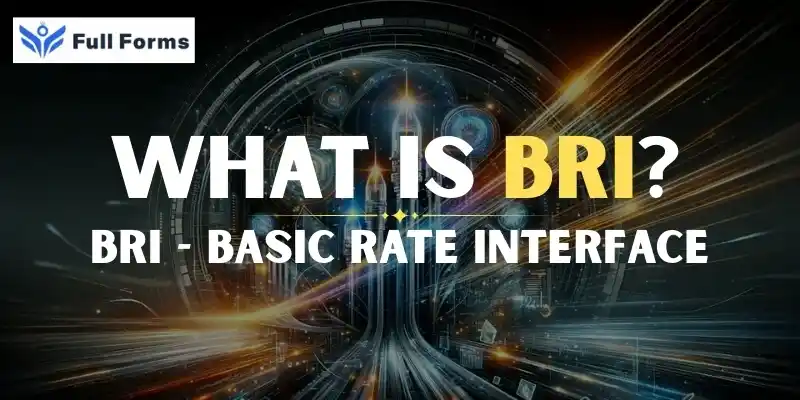Basic Rate Interface
(BRI)

Description
Most people are used to fast internet and modern ways to talk to each other. What they do not realize is that there are older technologies which have made the networks as it is today possible long before the coming of fiber optics and 5G. One of these technologies is the Basic Rate Interface, often just referred to as BRI. While not very popular in recent times, BRI played a crucial role at the onset of digital communication systems.
What is BRI?
First, we need to know what BRI is and what it does and why it was needed in the first place. So, BRI is a kind of ISDN service, where ISDN addresses Integrated Services Digital Network and it is known for replacing the ancient analog phone systems with a more rapid digital service and this is especially significant so that analog communication can be made into digital to enable the transmission of voice, video, and other forms of data over a basic phone line.
Why Was BRI Needed?
BRI is the simpler or “basic” form of ISDN. It was designed primarily for home users and small business applications in which high data rates were not needed, but voice capabilities alone were not enough.
How BRI Works
BRI operates over the existing telephone copper wiring to digitally connect the user with others. There are three channels in the service:
- Two B-channels (Bearer channels): Each running at 64 kbps, these carry user information such as voice, video, and data.
- One D-channel (Delta channel): Operating at 16 kbps, it carries control and signalling information to set up and coordinate calls or connections for data.
This arrangement is often referred to as 2B+D because it consists of two bearer channels and one data or control channel.
All in all, BRI has a data rate of 144 kbps (64 + 64 + 16 kbps).
How Does BRI Work?
BRI works using the copper telephone lines already in place. Digital signaling means it can send information much more clearly and accurately than older analog signals. Here’s the simple breakdown: A user connects his computer, telephone, or fax machine to the NT (Network Termination) device. The service provider’s ISDN line connects to the NT device.
You can have two communications running at the same time over the ISDN line. For example, one phone call on one B-channel and one fax or internet connection on the other.
D-channel handles the functions of call setup, dialling, and control of connections, allowing the B-channels to be used just for actual communication.
This allowed one line to be used for two things at once, a pretty big step over the days before broadband!
Single Line, Single Use
Separating voice and data into separate lines as mentioned above comes with one line for voice and another for the data.
Better Quality
Digital lines made voice calls sound clearer and data signals cleaner. Businesses could make video calls, premised early internet, and faxing through BRI without a glitch.
SOHO (small offices/home offices)
Where you need to talk to several at once but do not want to go to the expense of multiple phone lines.
BRI vs DSL or Cable Modems
BRI has been providing a quicker and more stable dial-up link than DSL or Cable Modems.
Where Stability Is Critical
Where digital lines are required and stability and reliability are of utmost importance.
Budget-Friendly Digital Service
There is a need for basic digital services by Banks, schools, government offices, etc but there is not much to spend.
BRI and PRI
BRI (Basic Rate Interface): 2B + D (144 kbps) – for the home and small business. PRI (Primary Rate Interface): For large corporations and institutions it has more channels (23B + D – North America, or 30B + D – Europe).
Why BRI is Getting Rarer Today
Nowadays, with broadband, fiber optics, and wireless, the BRI is practically worthless. Current connections to the internet are much faster and more flexible while being less expensive than the BRI.
This paragraph is written by a human. There is usually little to no need for Broadband networks with most of the inhabited world being covered, providing high speeds for users In a lot of regions even croplands and ranches are connected Though technically less developed underdeveloped regions also exist where such kind of technological networks maybe still absent using Broadband network in these areas enhances the coverage as it reduces the cost of implementing these spans It is good to use Broadband network spans instead of Base Rate Interface or ISDN in installing Drainage Monitoring systems which are costly to carry out
Conclusion
It has 2B + D channels so voice and data can be sent at the same time, making it ideal for home and small business use. This is where BRI mostly found its application at home and in very small businesses. It gave you a total of 144kbps over regular phone lines. Very old but nevertheless a step forward for most people towards modern digital communication.
Basic Rate Interface might be slow and primitive by today’s standards, but it was a quantum leap when it first appeared. It let people do more with just one line, like talk, fax, and use the internet all at once.
Having it BRI lets us realize just how far digital communications have come. It is the precursor to all the technologies that allow us high-speed internet, mobile data, and broadband today.
